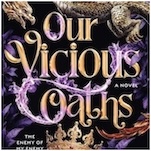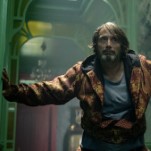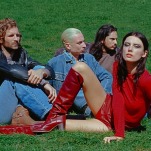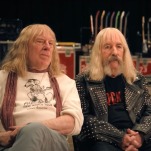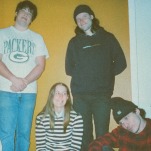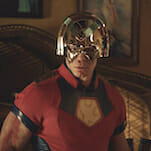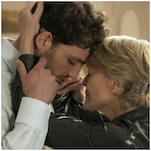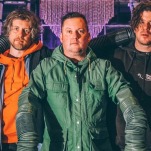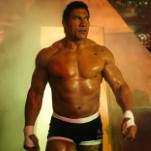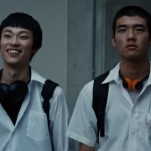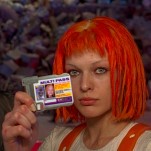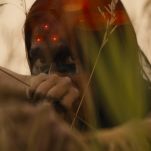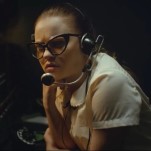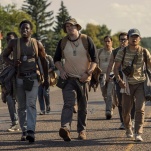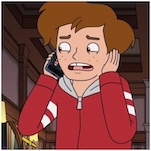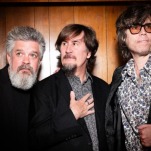Cloak & Dagger’s Joe Pokaski on the Vitality of New Orleans, Maneuvering Around the MCU and More
Photo: Freeform/Alfonso Bresciani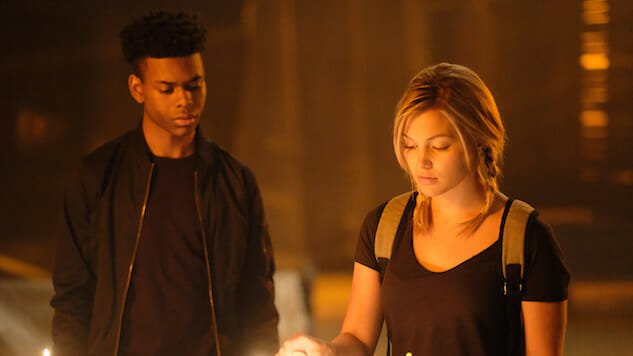
It’s rare to pull up a show on IMDb and find its popularity ranking in the single digits, but as of Monday, Freeform’s dramatically charged Marvel superhero joint, Cloak & Dagger, was sitting comfortably in ninth. Ninth! Out of just so many shows!
If you’ve been watching since the series premiered earlier this month, this single-digit coup will make total sense: Apart from FX’s surreal Legion, Cloak & Dagger is the most thematically and tonally challenging iteration of the MCU yet to have landed on linear television. And with its setting moved from New York to New Orleans, it’s also one of the most culturally distinct.
Series creator Joe Pokaski (previously of Paste favorite, Underground) got on the phone earlier this month to chat about that geographic change, the process of updating Cloak & Dagger for 2018, and the freedom Freeform allows its writer-producers.
Oh, and that little arthouse film Marvel released just weeks before Cloak & Dagger’s big premiere. Infinity… something?
Paste: The first thing we have to ask you about, obviously, is Infinity War. We know your development process for Cloak & Dagger started years ago, and the ad campaign launched months before Infinity War hit theaters, but now that the movie is out there—well, it might have been one thing to ignore the Avengers and focus on Tandy [Olivia Holt] and Tyrone’s [Aubrey Joseph] character-driven story, but if the consequences of the Avengers’ newest shenanigans is that half the world disappears, you can’t ignore that. How much of a heads-up were you given about the twist? Will Cloak & Dagger be addressing it?
Joe Pokaski: Wow, yeah—I feel like I see, like, three sniper scopes with lasers on me right now as I’m trying to figure out exactly what to tell you and what not to tell you…
Paste: Ha! Well, it seems like it has to take place before Infinity War, because it would be one thing for a couple of teens with legit problems to ignore the Avengers, but to have a whole season go by without anyone even referencing a half-population disappearance, that seems impossible.
Pokaski: Yeah, yes—that’s the answer. The answer I can give you, with loaded emphasis, is that Season One definitely takes place before Infinity War. That’s all I can say. I wish I could say more, but they… they might literally kill me! I think it’s in my contract that they could kill me if I said more.
Paste: Well, let’s try to get to a question you maybe won’t get in trouble for answering, about the process of developing the show. You’ve said you had such a long runway for it—from when you started working on it to when it finally came out, so much has changed in the bigger Marvel universe. Did you have to adapt to those changes at all throughout the development process?
Pokaski: Um, no, to be honest. You’d think we would have, I mean, but I think it’s one of the beauties of Tandy and Tyrone, and of Cloak & Dagger in general, is that they kind of exist concurrently with the universe no matter what happens, it’s kind of one of the reasons I love the comic book characters so much. Because they could show up in any book, and you’d be like, oh, Cloak and Dagger are here!
I think the benefit we have is we were telling a relatively progressive story, we were trying to be a little more inclusive as to who gets represented as superheroes, so I think some of the benefits of at least putting this plate on the table [now] is that Black Panther has shown up, that Captain Marvel is going to show up. The timings of things [can] always seem like they’re kind of serendipitous, but this feels like a good moment in the Marvel Universe—and to be honest, in genre television—to be putting Tandy and Tyrone in front of everybody because it feels like the time is perfect for it.
Paste: But you’re right, in terms of the more superhero-y aspects of the Marvel world, nothing in the film universe until now would have changed things for Tandy and Tyrone much at all.
Pokaski: No, it hasn’t really at all. Again, that’s part of the fun—Cloak and Dagger can often go away for two years and come back, and it’s not a big deal.
Paste: Like, Hydra could for sure have been behind everything, but Roxxon as an evil corporation is just as believable now.
Pokaski: Exactly. And the fun part about at least our version of Roxxon is that it’s not an evil corporation, it’s an amoral corporation—which basically turns you to evil, once you start looking [just] at profit.
Paste: Okay, we’ll move past the Marvel stuff so the snipers can go take a lunch break. As frequent Freeform viewers here at Paste, we do have a general sense of what the network has been like for the past couple of years, and your show is such a departure from that tone. Like, Pretty Little Liars got into a lot of psychological scary stuff, some gender stuff, some tearing down of the patriarchy, but in terms of visuals and the tonal quality, your show is so different from just about everything else on the network (except, maybe, Siren). The color, the grittiness, the handheld camera—Gina Prince-Bythewood’s direction [of the pilot] was obviously great—but the whole thing is just so far from what one would expect to see on Freeform. So how has the development process been like with the network? Have you had to fight for anything?
Pokaski: Honestly, it’s been fantastic. Absolutely, we have to fight for things every once in a while, but I think part of it—you know, I have to say that I didn’t quite understand what they meant when they changed their name to Freeform, but I think I understand now, having worked with them, is that they want people to tell stories in their own way. If you look at the shows you named, or if you look at, you know, The Bold Type, which is just a radical feminist show. I think grown-ish is awesome. And I think our show fits in their bucket of, “We’re just going to go for quality and we’re going to let our auteurs define the tone”—I think a little more than some networks might let you do that. And I think if you look at the great networks, you look at Mad Men and Breaking Bad existing on the same network, that’s kind of how you break out and define yourself as, you know, writer-producer friendly.
{Editor’s note: The following contains spoilers from the episodes of Cloak & Dagger that have aired to date.]
Paste: Let me—can I guess what some of the things you might have had to fight for were? [Laughs] The lynching scene? The headshot murder in the law office? The opiate snorting? I mean…
Pokaski: You’d be surprised! You’d be surprised! You’d be surprised how many they were totally OK with or even encouraged us to go after. I mean, most of those things were actually encouraged. I was actually really surprised because I did the same thing you did, where I prepared myself to have to fight for these things, and then they came and went and we were like, OK! Either they didn’t see that, or they were totally cool with it.
And Gina [Prince-Bythewood] and I were very clear at the beginning that we wanted this to be about something, that we didn’t want it to be a white male superhero story told, you know, told through people who just happened not to look like white males. So all the things you mentioned there, we wanted to make sure we were selling how real the world was, and explaining why it needs heroes.
Paste: That’s one of the things we were noticing and really enjoying about these first four episodes, is how specific the show is. We know the shift to New Orleans really helped that—somehow New York just becomes a general story, when every other show is set there. There is Runaways, which is more specific to L.A.
Pokaski: Yeah, in no other city could you do that cult religion than Los Angeles!
Paste: So for you guys, New Orleans is not just a backdrop, and we’ve really been interested in some of the things that you’ve chosen to include like the voodoo tour, and the church, and specifically—is it a krewe? Is that what you call it, that Tyrone’s dad belongs to? Where he gets the cloak?
Pokaski: Yeah, yes, yes, the Mardi Gras Indians.
Paste: Obviously these two characters have to get their costumes in some way, but this makes it really—it really does bring it down to a personal level for that cloak to come from where it does [Tyrone’s dead older brother, via the Indians]. Like you were saying about the cult in L.A., nowhere but New Orleans could be more perfect for a superhero whose signature thing is a cloak.
Pokaski: Yeah, I think a lot of that was intentional, just trying to make sure we used New Orleans, and I think honestly just try to give them a mythology that hasn’t been done before, which is tough, with so many movies and television shows on the air. But then the other is, I just really have to thank my writing staff. We just try to fill the room full of people with a diverse amount of experience, and one of them, Marcus Guillory, he’d spent a lot of time in New Orleans and was like, have you heard of the Mardi Gras Indians? And we started learning about it, and it was just it was something I hadn’t seen on television. I became obsessed with the idea of a father teaching his son how to be a man by sewing. And I just think there was such a nice life lesson there, and the more we learned about it, we were like, “Oh, this is obviously where the the first iteration of the cloak is going to come from.” Because like you said, when you look at the design, it’s really the only place it could come from. So it was one of those things where the more we learned about the city, the more we learned about Vodoun and Catholicism and how they related, it did a lot of our work for us. It created this great backdrop that I hadn’t seen before to tell the stories of these kids.
And the Mardi Gras Indians story in particular is really interesting because, you know, it’s a group of generally black men who do it to honor the Indians who helped the freed and runaway slaves, and they’re basically kind of honoring how they helped them survive as things were rough. And it just feels like such an interesting story that I’d never heard before, and it felt kind of heroic in the Marvel way.And a lot of the consultants that helped us—a lot of the men in those scenes were actually Indians—who are also sometimes called Black Indians, different people prefer different terms—but a lot of the men in the scene are Indians themselves, and they brought their own costumes, and it was great because we basically had a room of consultants. Even the song we play in [the fourth episode] was composed by a couple of them. It was very cool.
Paste: Along the lines of that specific piece of local history and cultural feeling heroic in a Marvel way, there is this essay in n+1 (“We’re the Good Guys, Right😉 that really convincingly took issue with the Avengers in the Marvel Cinematic Universe, and how in the MCU they are really less avengers righting injustices than they are authoritarian protectors defending the status quo through force, who are all godheads or kings or monarchs or whatever, kings of industry—not exactly representatives of the everyday person. But then we were watching your show and it was like, but Cloak and Dagger! They’re avengers!
Pokaski: Right! I think that A, that’s a great observation, and also the thing I love about the MCU is that they’re starting to explore that. Like, I think the idea of Killmonger was right, it’s such an interesting one to explore. And even just looking at—like, it was going to be silly, but when Peter Parker decided to be a neighborhood Spider-Man, that was a big moment. We have room for different kinds of heroes, and I think Tandy and Tyrone have always been—I mean, no surprise they showed up in Spider-Man. They are very much the kind of personal-level heroes who can go avenging. And they obviously have two things to avenge very quickly in these first four episodes.
Paste: On a much lighter (for us) final note, we want to hear the backstory of using the 3D printer for the voodoo doll of Tyrone.
Pokaski: [O]ne of the Voudon priestesses, one of the head women, is also a lawyer. And it’s a really interesting thing where it’s like, it’s a world where you don’t have to necessarily be Old World, you don’t have to deny the modernity of the world. That’s when we started talking about how you could best make what is now known as a voodoo doll conventionally. It was like, well, why wouldn’t you do a 3D printer? That feels like the best way to represent it, and it just felt like, again, something we hadn’t seen before, and that’s something that represented what we wanted to do with our show, bringing the old and the new together.
Paste: How did you get it to be Aubrey Joseph? What was the modeling process? Because it looks exactly like him.
Pokaski: We sent Aubrey and our visual effects supervisor Donny to Atlanta to be complete body scanned, and he had a gigantic jar of Vaseline with him, which got him pulled into the TSA line, and he almost got arrested. But yeah, he sat patiently for hours as they scanned [him] from every angle. And we were still surprised when the 3D printer put it out and made the perfect version of him.
Paste: Man, technology is crazy.
Pokaski: It is! And spoiler alert: The Tandy one is not 3D printed. So it’ll be fun to see how that works out.
Marvel’s Cloak & Dagger airs Thursdays at 8 p.m. on on Freeform. Watch our interview with stars Olivia Holt and Aubrey Joseph here.
Alexis Gunderson is a TV critic whose writing has appeared on Forever Young Adult, Screener, and Birth.Movies.Death. She’ll go ten rounds fighting for teens and intelligently executed genre fare to be taken seriously by pop culture. She can be found @AlexisKG.


















